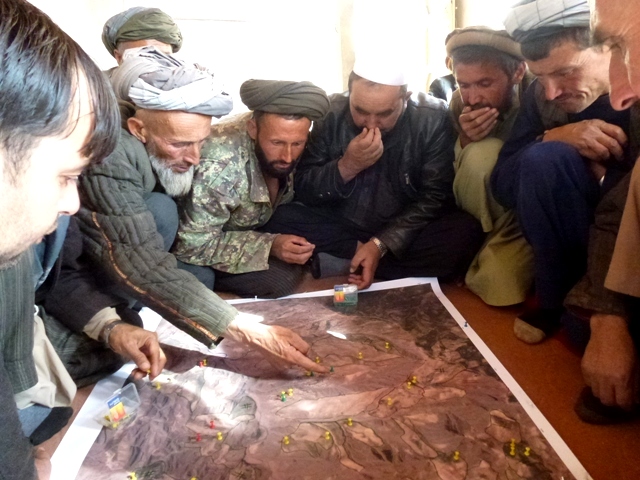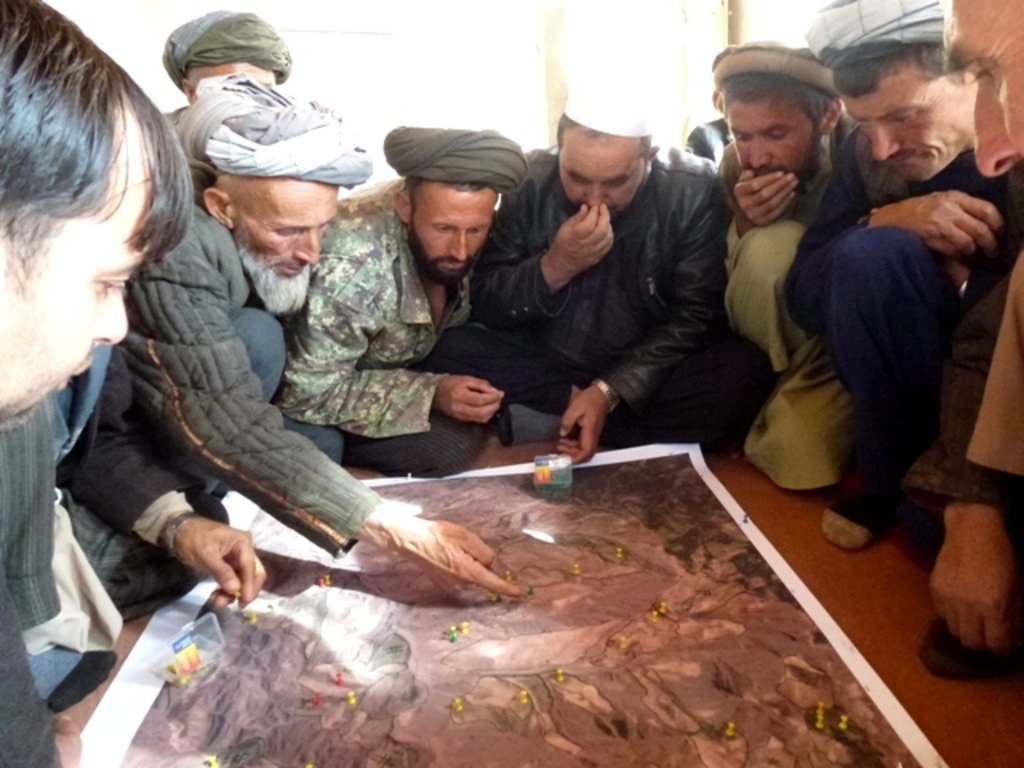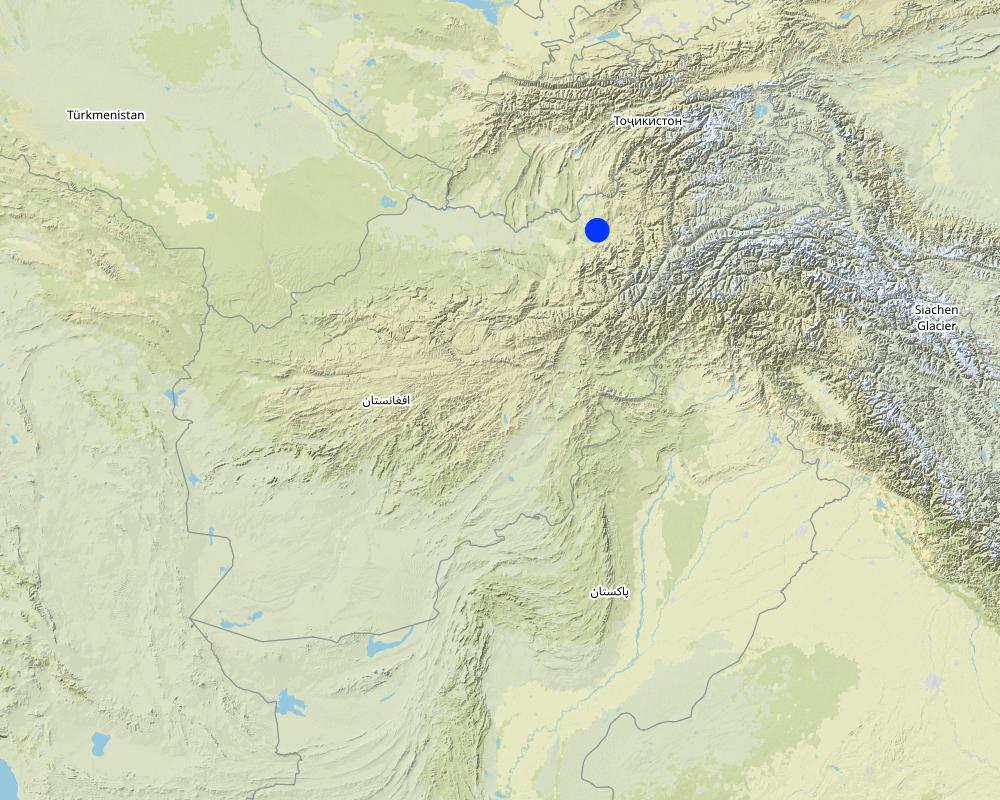Watershed Associations (WSA) and Natural Resource Management Committees (NRMC) [阿富汗]
- 创建:
- 更新:
- 编制者: Bettina Wolfgramm
- 编辑者: Roziya Kirgizbekova, Aqila Haidery
- 审查者: William Critchley
approaches_545 - 阿富汗
查看章节
全部展开 全部收起1. 一般信息
1.2 参与方法评估和文件编制的资源人员和机构的联系方式
有助于对方法进行记录/评估的项目名称(如相关)
Potential and limitations for improved natural resource management (NRM) in mountain communities in the Rustaq district, Afghanistan (Rustaq NRM Study)有助于对方法进行记录/评估的机构名称(如相关)
Terre des Hommes (Terre des Hommes) - 瑞士有助于对方法进行记录/评估的机构名称(如相关)
CDE Centre for Development and Environment (CDE Centre for Development and Environment) - 瑞士1.3 关于使用通过WOCAT记录的数据的条件
(现场)数据是什么时候汇编的?:
17/10/2016
编制者和关键资源人员接受有关使用通过WOCAT记录数据的条件。:
是
1.4 SLM技术问卷的参考
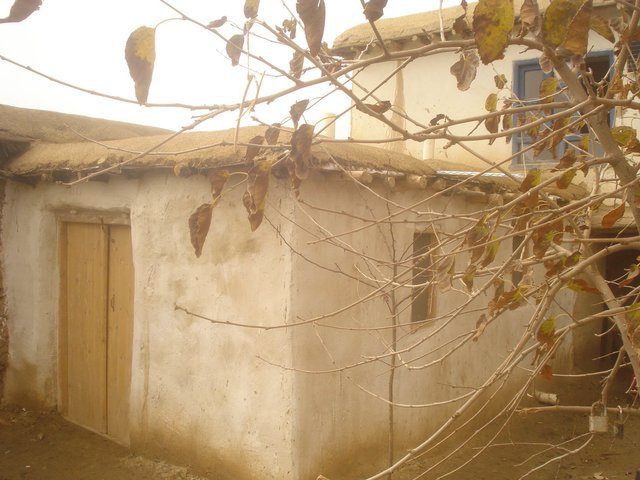
Improved livestock shed for better health and productivity [阿富汗]
Existing livestock sheds can be improved through interior and exterior refurbishing, and door and window installation. More favourable indoor conditions benefit animal health and the quality of animal products.
- 编制者: Bettina Wolfgramm
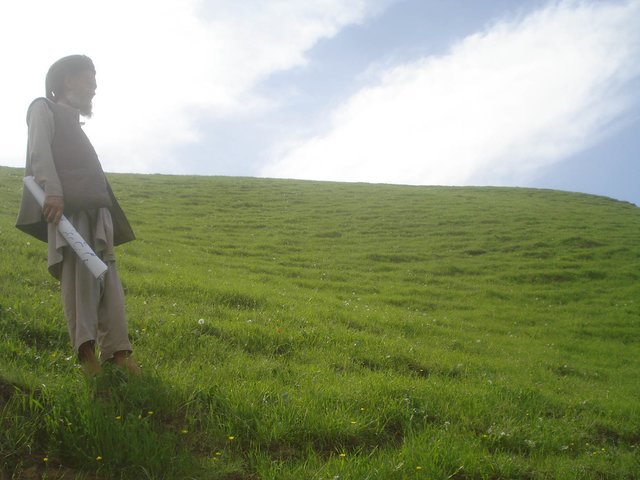
Rotational grazing to restore degraded pastures [阿富汗]
A plan for rotational grazing has been developed to control pasture use and prevent overgrazing of rehabilitated pastures.
- 编制者: Bettina Wolfgramm
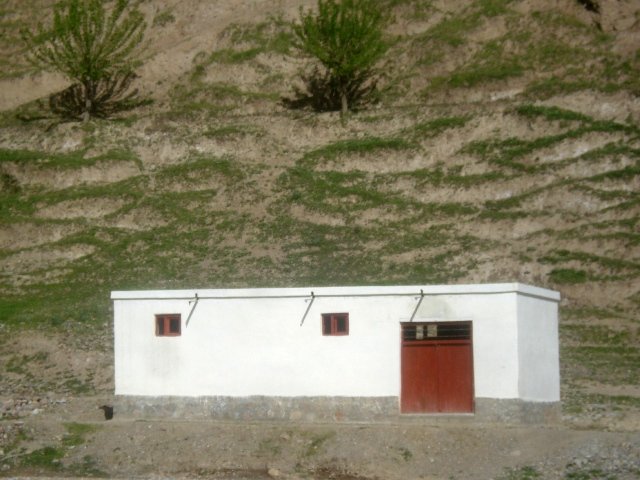
Community fodder bank for sustaining supplies [阿富汗]
Community fodder banks have been established in villages for the purpose of ensuring supplies of livestock fodder during winter, to prevent loss of livestock and to prevent over-grazing early in spring.
- 编制者: Bettina Wolfgramm
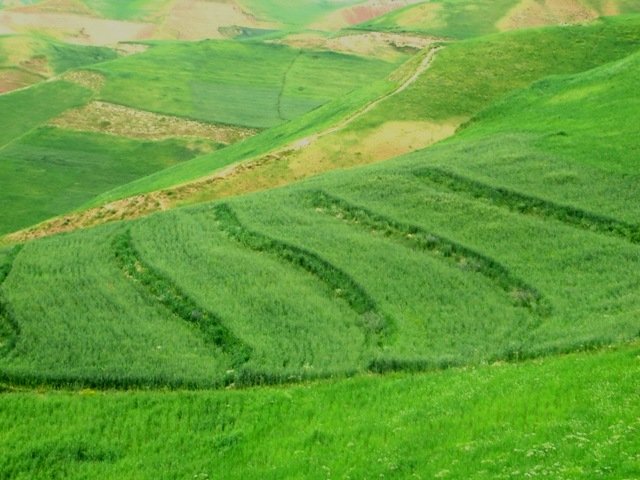
Terraces with improved seed and fertilizer application [阿富汗]
Terraces are established on mountain slopes used mainly for cropping wheat, with the purpose of soil protection from erosion, preserving runoff, sediments and nutrients on-site. Improved seeds and fertilizer are applied on the terraces for increasing crop yield, but also vegetation cover and biomass production, and thus prevent further land …
- 编制者: Roziya Kirgizbekova
2. SLM方法的描述
2.1 该方法的简要说明
Two Watershed Associations (WSA), in Chaker and Nahristan watershed areas respectively, are registered at the national level with the Ministry of Agriculture Irrigation and Livestock (MAIL) and at the regional level with the Department of Agriculture. Both associations are strong, active, dynamic, and have the capacity to coordinate and support the Natural Resource Management Committees (NRMC) at village level.
2.2 该方法的详细说明
该方法的详细说明:
Terre des Hommes (Tdh) has been implementing the Livelihood project (LIPT) in Rustaq district in northern Afghanistan since 2007. The overall aim of the project is to offer the rural population new and improved livelihood options, with capacity building of the rural population, to design and implement their own sustainable development options, and to enhance their resilience to cope with natural and conflict-related stress. For this purpose, capacity of supporting stakeholder institutions is strengthened (LIPT’s boundary partners) to ensure that good development is on-going. Boundary partners are trained and equipped in relevant techniques regarding sustainable natural resource management.
Two Watershed Associations (WSA) and 20 Natural Resources Management Committees (NRMC) were founded through LIPT. Two WSAs, in Chaker and Nahristan watershed areas, are registered at national level within the Ministry of Agriculture Irrigation and Livestock (MAIL), and at the regional level with the Department of Agriculture. Both associations are strong, active, dynamic, and have the capacity to coordinate and support the NRMCs at village level. Out of their newly established and registered regional offices, the WSAs coordinate the NRMCs, take over responsibilities from Tdh (e.g. the 2014 reforestation campaign) and are getting more involved in planning and monitoring of LIPT’s activities. The 20 NRMCs have "hands and eyes" on all LIPT activities implemented in their communities, and their trained extension workers render valuable services to the farmers in their villages.
Methods: Today, all NRMCs have a strong institutional set-up. Their extension workers have been trained and equipped. Members of NRMCs and WSAs have been trained on group management, planning, documentations, record keeping, IPM, reforestation management, soil protection, mulching, hedgerows and terracing, making fermenters, pruning and budding. WSAs and NRMCs gained further organizational, technical and management capacity building in both watershed areas. As one of biggest challenge at watershed level is soil erosion within hillside agriculture, LIPT III trained the NRMCs and WSAs on terracing and hedgerows to protect the soil from erosion. Furthermore, NRMCs were trained in sustainable irrigation water management, gully treatment, and surface water harvesting. There were also training courses conducted on leadership, finance, proposal writing, documentation, procurement and operations management.
Both WSAs and NRMCs started to get a real understanding of environmental issues and were then able to motivate their communities. WSAs coordinated the NRM intervention with NRMCs including reforestation, soil protection hedgerows, contour lines, terracing, establishment of public nurseries (to produce trees and be an income source for WSAs), establishment of centralized community bakeries (to reduce the demand for firewood and decrease the women’s workload in the watershed areas), irrigation infrastructure, bio-engineering and gully control (to reduce the progression of gullies on both ploughed lands and pastures), livestock value chains at regional (watershed) level, etc., while NRMCs are looking after these interventions and the mobilization of the community at the village level. Farmers and communities have adopted natural resource management practices to maintain/increase soil fertility, rangeland, water resources and forest coverage.
2.3 该方法的照片
2.5 采用该方法的国家/地区/地点
国家:
阿富汗
区域/州/省:
Tahor Province, Rustaq districts
有关地点的进一步说明:
Dashti Mirzai, Javaz Khana and Sari Joy villages
Map
×2.6 该方法的开始和终止日期
注明开始年份:
2007
若不知道准确的年份,请注明该方法的大致开始日期。:
不到10年前(最近)
2.7 方法的类型
- 基于项目/方案
2.8 该方法的主要目的/目标
The main aim of the project is to offer the rural population new and improved livelihood options and to deliver capacity building for the rural population to design and implement their own sustainable development options and enhance their resilience to cope with natural and conflict related stress.
2.9 推动或妨碍实施本办法所适用的技术的条件
社会/文化/宗教规范和价值观
- 启动
The functions of men and women are clearly distinguished within Afghan society, while at the same time within the family this division of work and functions also results in men and women working hand-in-hand. An improvement of the family’s livelihood situation is expected to positively affect all family members. However. it is recognized that the involvement of women is key in order to secure basic human rights for everyone, to achieve good governance, sustainable development, and to efficiently contribute to poverty reduction (SDC 2004), it is also clear that a context sensitive approach is of high importance.
- 阻碍
Lack of capacity of the rural population to design and implement sustainable development options; vulnerability to natural and conflict related stress
机构设置
- 启动
Establishment of Watershed Associations (WSA) and Natural Resources Management Committees (NRMC)
- 阻碍
Lack of institutions at the community level to introduce natural resource management options
了解SLM,获得技术支持
- 启动
Training has improved technical knowledge
- 阻碍
Lack of technical knowledge
3. 相关利益相关者的参与和角色
3.1 该方法涉及的利益相关者及其职责
- 当地土地使用者/当地社区
The overall aim of the project is to offer the rural population new and improved livelihood options and give capacity building to the rural population to design and implement their own sustainable development options, and enhance their resilience to cope with natural and conflict related stress.
- 社区组织
Watershed Associations (WSA) and Natural Resources Management Committees (NRMC)
- 国际组织
Terre des Hommes , SDC
3.2 当地土地使用者/当地社区参与该方法的不同阶段
| 当地土地使用者/当地社区的参与 | 指定参与人员并描述活动 | |
|---|---|---|
| 启动/动机 | 无 | |
| 计划 | 互动 | |
| 实施 | 互动 | |
| 监测/评估 | 互动 |
3.4 有关SLM技术选择的决策
具体说明谁有权决定选择要实施的技术:
- 所有相关参与者,作为参与式方法的一部分
4. 技术支持、能力建设和知识管理
4.1 能力建设/培训
是否为土地使用者/其他利益相关者提供培训?:
是
明确受训人员:
- 土地使用者
- 现场工作人员/顾问
4.2 咨询服务
土地使用者有权使用咨询服务吗?:
是
指明是否提供了咨询服务:
- 在土地使用者的土地上
4.3 机构强化(组织发展)
是否通过这种方法建立或加强了机构?:
- 是,适度
具体说明机构的强化或建立程度:
- 本地
- 区域
- 国家
说明机构、角色和职责、成员等。:
LIPT III will leave behind successful and strong boundary partners in place to carry out the development options, as main boundary partners (WSAs, NRMCs, as the major boundary partners) will have a source of income for their operation and management.
具体说明支持类型:
- 财务
- 能力建设/培训
- 设备
4.4 监测和评估
监测和评估是该方法的一部分吗?:
是
4.5 研究
研究是该方法的一部分吗?
是
明确话题:
- 经济/市场营销
- 技术
提供进一步的细节,并指出是谁做的研究:
On-going research, as well as multiple trials by LIPT to find the best-adapted technical solutions, to communicate and discuss them with local communities and farmers, were the key elements of this success.
5. 融资和外部物质支持
5.1 该方法中SLM组成部分的年度预算
如果不知道准确的年度预算,请给出一个范围:
- 10,000-100,000
5.2 为土地使用者提供财政/物质支援
土地使用者是否获得实施该技术的财政/物质支持?:
是
如果是,请具体说明支持的类型、条件和提供者:
Fully supported under project
5.4 信用
是否根据SLM活动的方法给予信用值?:
否
5.5 其它激励或手段
是否有其他激励措施或工具用于促进SLM技术的实施?:
是
如果是,请具体说明:
local institution were support with equipment
6. 影响分析和结论性陈述
6.1 方法的影响
该方法是否帮助土地使用者实施和维护SLM技术?:
- 否
- 是,很少
- 是,中等
- 是,支持力度很大
NRM is the area where LIPT III made the most remarkable progress despite the fact that NRM was a completely new approach, and its implementation is highly demanding in terms of manpower, community awareness and mobilization. Profound changes in behaviour, motivation and mobilization both at individual and community levels made this possible. On-going research, as well as multiple trials by LIPT to find the best-adapted technical solutions, and to communicate and discuss them with local communities and farmers, were the key elements of this success. The NRMCs, WSAs as well as individual farmers in both watershed areas increased their knowledge and gained a better understanding of the importance of sustainable management, rehabilitation of farm land, pastures and their main natural resources. Farmers adapt and replicate the innovations once they see the results, farmers interest became high and they are ready to replicate it to protect their land form degradation.
该方法是否提高了土地使用者实施土地管理的知识和能力?:
- 否
- 是,很少
- 是,中等
- 是,支持力度很大
Farmers adapt and replicate the innovations. Once they see the results, farmers' interest became high and they are ready to replicate it to protect their land from degradation.
该方法是否会带来就业、收入机会?:
- 否
- 是,很少
- 是,中等
- 是,支持力度很大
One Example: Under irrigation water improvement interventions, LIPT in coordination with NRMCs brought more 110 ha land under irrigation and the yield is expected to be doubled in this agricultural land, and NRMCs are trained on sustainable irrigation water management, gully treatment, and surface water harvesting
6.2 土地使用者实施SLM的主要动机
- 增加生产
- 减少土地退化
- 降低灾害风险
6.3 方法活动的可持续性
土地使用者能否维持通过该方法实施的措施(无外部支持的情况下)?:
- 是
若是,请说明如何维持:
To look to the capacity and institutional strengthening of the project boundary partners, LIPT III will leave behind a successful and strong boundary partner in place to carry out the development options, as main boundary partners will have source of income (nurseries, cooperative shop, etc.) for their operation and management.
6.4 该方法的长处/优点
| 土地使用者眼中的长处/优势/机会 |
|---|
| The traditional social structures and customary institutions play an important role in problem solving in everyday community life, but traditional problem solving structures may also limit the taking up of new approaches. More effective approaches are needed, for example in the field of the management of common pool resources (water, pastures, trees and shrubs). The newly established Watershed Associations demonstrate how groups addressing specific urgent tasks may be successfully established and functioning within a very short period of time. |
|
NRM is the area where LIPT III made the most remarkable progress despite the fact that NRM was a completely new approach, and its implementation is highly demanding in terms of manpower, community awareness and mobilization. Profound changes in behaviour, motivation and mobilization both at individual and community levels made this possible. The permanent research, as well as multiple trials by LIPT to find the best-adapted technical solutions, to communicate and discuss them with local communities and farmers were the key elements of this success. WSAs and NRMCs are playing an active role in implementation of NRM intervention, even they have become more interested and active when they registered in Department of Agriculture Irrigation and Livestock at national and regional level. |
| Farmers adapt and replicate the innovations once they see the results, as soil erosion is the main concern in Rustaq - but nobody in watershed area was ready to protect their agriculture land by implementing barrier hedgerows. After demonstrating of hedgerow by LIPT III, farmers saw its impact on controlling of soil erosion, farmers' interest became high and they are ready to replicate it to protect their land from degradation. |
|
All community extension workers are trained and in place, playing an essential role in supporting the boundary partners in implementing NRM activities that include community mobilization, technical design of orchards and nurseries, reforestation sites, terracing and hedgerow designs. The NRMCs, WSAs as well as individual farmers in both watershed areas increased their knowledge and gained better understanding of the importance of sustainable management, rehabilitation of farmland, pastures and their main natural resources. A high degree of motivation and mobilization of farmers, and adequate technical capacity of CEWs regarding NRM is certainly one of the main outcomes of the LIPT, and an essential step towards the fulfilment of LIPT’s mission. |
| 编制者或其他关键资源人员认为的长处/优势/机会 |
|---|
| A rewarding sign of the development of NRM awareness is how farmers took up the problem of soil erosion.100 ha of cultivable land on hillsides have been terraced since the terracing activity had been initiated in November 2013. And 155 ha of additional land are in the process of being terraced. The biggest success with terracing is that a number of farmers started replication themselves what they had seen. |
7. 参考和链接
7.1 方法/信息来源
- 实地考察、实地调查
- 根据报告和其他现有文档进行编译
链接和模块
全部展开 全部收起链接

Improved livestock shed for better health and productivity [阿富汗]
Existing livestock sheds can be improved through interior and exterior refurbishing, and door and window installation. More favourable indoor conditions benefit animal health and the quality of animal products.
- 编制者: Bettina Wolfgramm

Rotational grazing to restore degraded pastures [阿富汗]
A plan for rotational grazing has been developed to control pasture use and prevent overgrazing of rehabilitated pastures.
- 编制者: Bettina Wolfgramm

Community fodder bank for sustaining supplies [阿富汗]
Community fodder banks have been established in villages for the purpose of ensuring supplies of livestock fodder during winter, to prevent loss of livestock and to prevent over-grazing early in spring.
- 编制者: Bettina Wolfgramm

Terraces with improved seed and fertilizer application [阿富汗]
Terraces are established on mountain slopes used mainly for cropping wheat, with the purpose of soil protection from erosion, preserving runoff, sediments and nutrients on-site. Improved seeds and fertilizer are applied on the terraces for increasing crop yield, but also vegetation cover and biomass production, and thus prevent further land …
- 编制者: Roziya Kirgizbekova
模块
无模块


